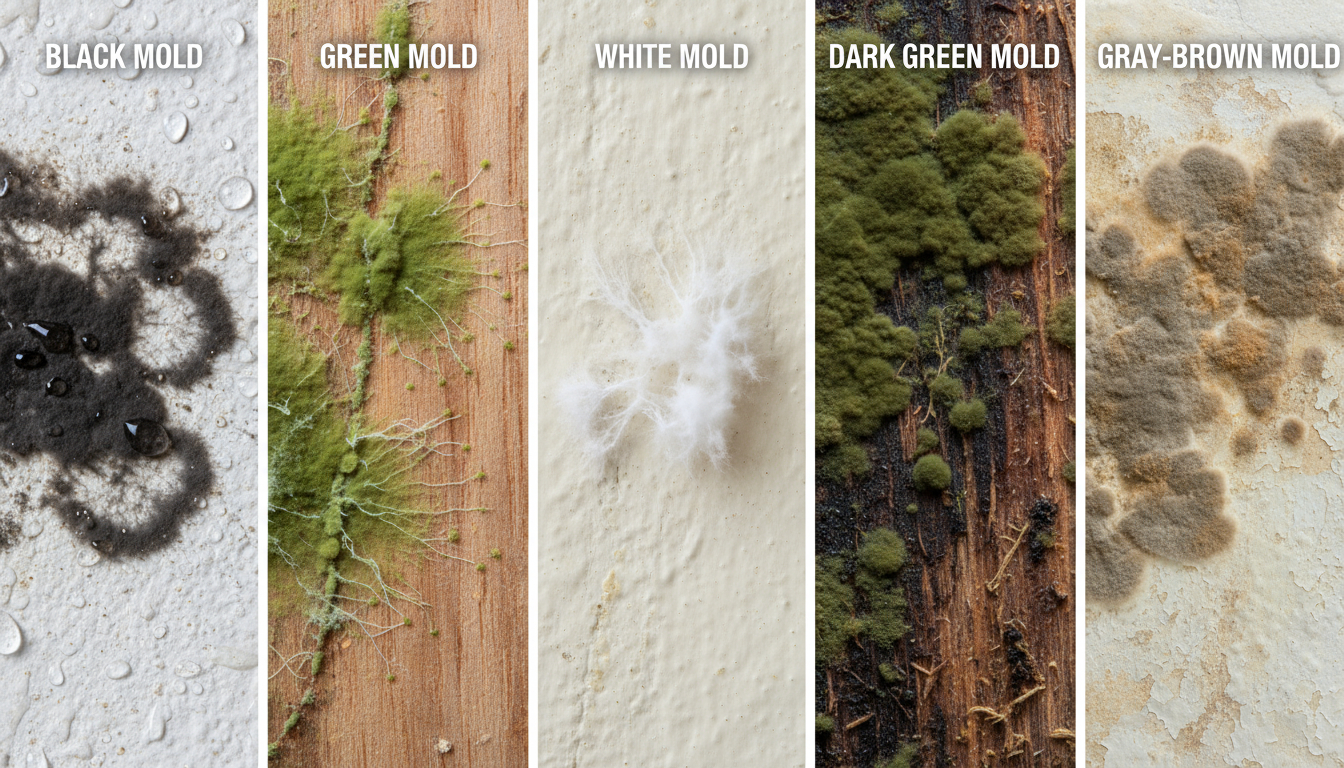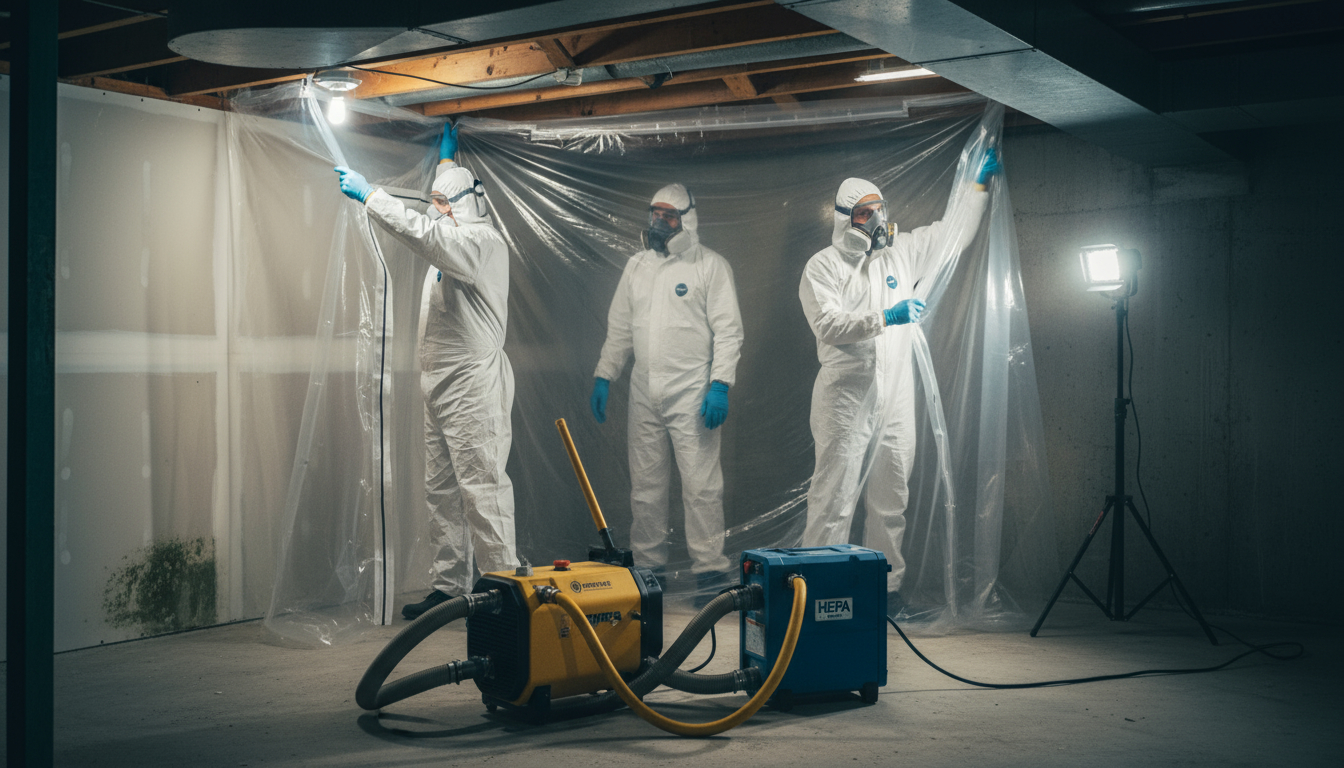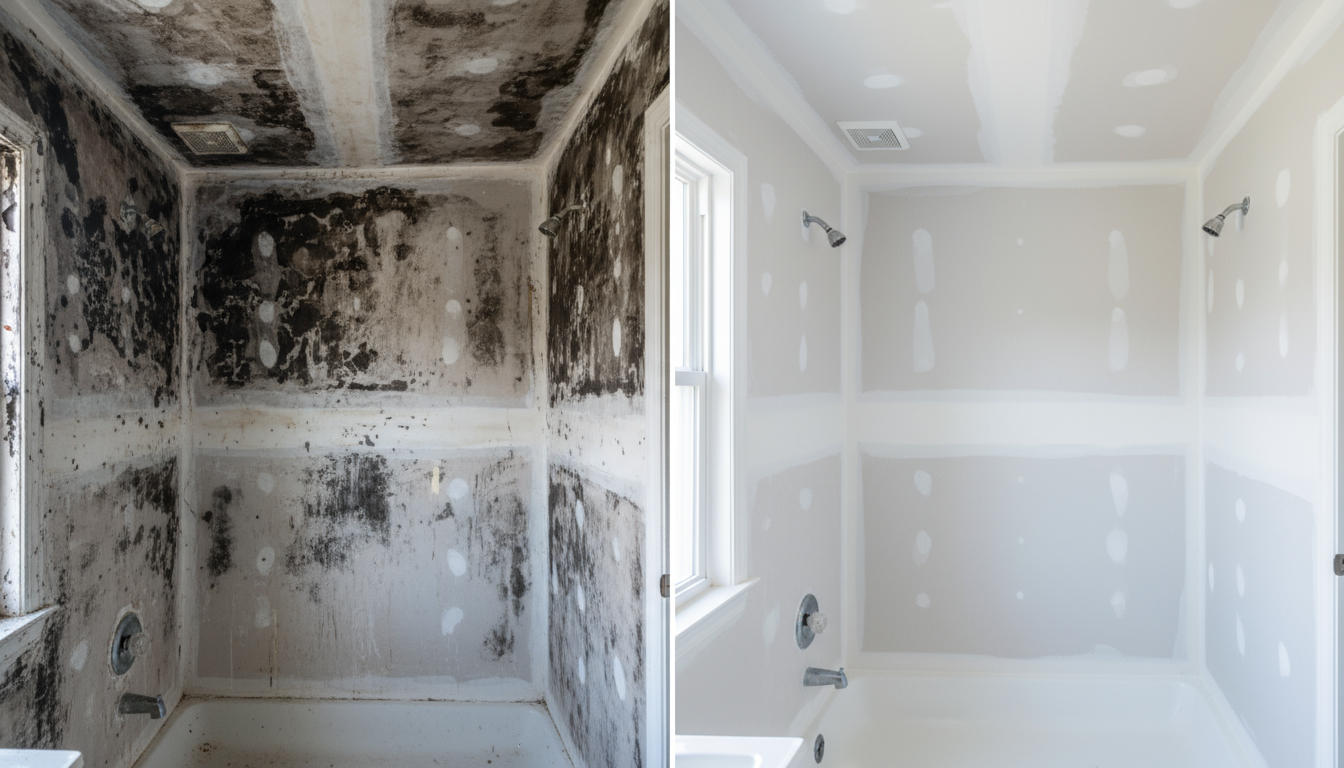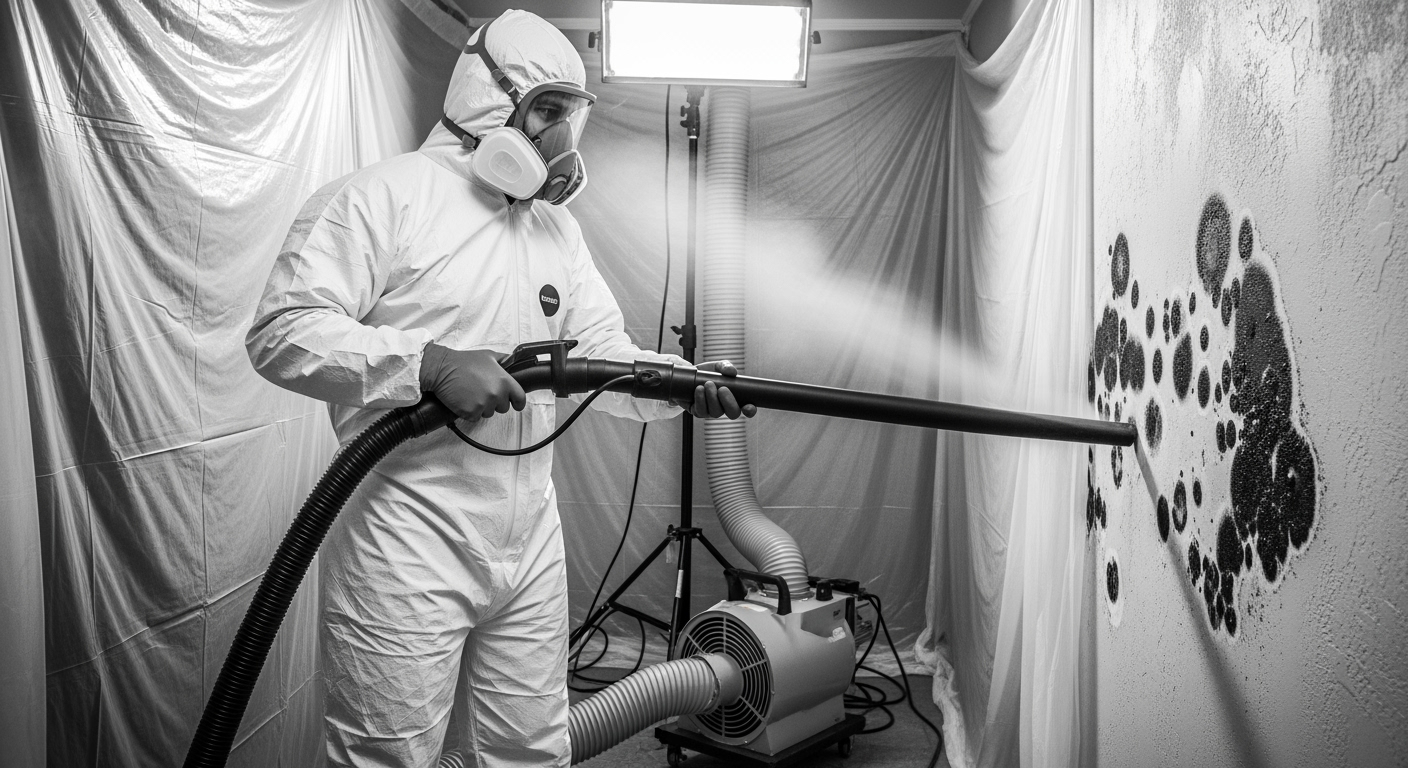What is Mold Remediation?
Mold remediation is the comprehensive process of identifying, containing, removing, and preventing mold growth in buildings. Unlike simple surface cleaning, professional remediation addresses both visible mold colonies and hidden growth throughout the affected area while correcting the underlying moisture problems that allowed mold to flourish. Think of it as treating both the symptoms and the disease—removing existing mold while eliminating conditions that promote future growth in your building.
The process goes far beyond what you might see in DIY tutorials or home improvement shows. Professional remediation involves specialized equipment, containment procedures, and systematic approaches that ensure complete mold removal without spreading spores to clean areas of your building. It’s the difference between temporarily masking a problem and permanently solving it.
⚠️ Important: Mold remediation is not the same as mold removal. Complete mold removal is impossible since mold spores exist naturally in the indoor environment. Remediation focuses on returning mold levels to normal, natural levels that don’t pose health risks or property damage.
How Does Mold Remediation Work?
Professional mold remediation follows a systematic, scientific approach that ensures thorough treatment while protecting unaffected areas in your building. The process typically unfolds in distinct phases, each critical to achieving lasting results. Understanding these steps helps property owners know what to expect and why cutting corners can lead to recurring problems in any indoor space.
Step-by-Step Remediation Process
- Initial Assessment and Testing: Professionals conduct moisture mapping, indoor air quality testing, and visual inspection to determine the extent of contamination throughout the area
- Containment Setup: Physical barriers and negative air pressure prevent spore spread to clean areas of the building during work
- Air Filtration: HEPA air scrubbers run continuously to capture airborne spores and maintain indoor air quality
- Removal of Affected Materials: Contaminated porous materials like drywall and insulation are safely removed from the area and disposed
- Cleaning and Treatment: Non-porous surfaces throughout the affected area are cleaned with antimicrobial solutions and specialized techniques
- Drying and Dehumidification: Industrial equipment ensures complete moisture removal from the building structure and indoor air
- Restoration: Removed materials are replaced and affected areas of the building are rebuilt to pre-damage condition
- Final Testing: Post-remediation verification ensures mold levels in the indoor environment have returned to acceptable ranges
Each phase requires specific expertise and equipment. For instance, containment isn’t just hanging plastic sheeting—it involves calculating air exchange rates for the area, establishing decontamination chambers, and maintaining precise pressure differentials. This attention to detail separates professional remediation from amateur attempts.
Types of Mold and Remediation Approaches
Not all mold is created equal, and different types require tailored remediation strategies for your building. While over 100,000 mold species exist, certain types commonly affect properties and pose varying levels of concern to indoor environments. Understanding these differences helps explain why professional assessment is crucial for effective remediation in any business or residential area.
| Mold Type | Common Locations | Remediation Approach | Special Considerations |
|---|---|---|---|
| Aspergillus | HVAC systems, walls, insulation areas | HEPA vacuuming, antimicrobial treatment | Often requires duct cleaning in building |
| Penicillium | Water-damaged materials, carpet areas | Material removal, deep cleaning | Spreads quickly through indoor spaces |
| Stachybotrys (Black Mold) | Chronically wet areas, behind walls | Complete removal, extensive containment | Requires highest safety protocols |
| Cladosporium | Fabrics, wood surfaces, HVAC areas | Surface cleaning, material replacement | Can grow in cool indoor temperatures |
| Alternaria | Showers, window frames, attic areas | Moisture control, surface treatment | Fast-growing, needs quick response |
The remediation approach varies based on both the mold type and the affected materials in your building. Porous materials like carpet and drywall in the contaminated area typically require removal when contaminated, while non-porous surfaces like metal and glass can often be cleaned and salvaged. This distinction significantly impacts project scope and timeline for any business or residential property.
💡 Pro Tip: Color doesn’t determine mold toxicity. While “black mold” gets attention, many dangerous molds appear white, green, or gray in indoor spaces. Professional testing identifies species accurately, ensuring appropriate remediation methods for your building.

Benefits of Professional Mold Remediation
Professional mold remediation delivers benefits that extend far beyond simple mold removal in your building. When done correctly, it protects your property value, ensures occupant health in indoor environments, and provides long-term peace of mind. Studies show that properties with documented professional remediation maintain 15-20% higher resale values compared to those with DIY attempts or unaddressed mold issues in any area.
Health and Safety Benefits
- Improved Indoor Air Quality: Professional remediation reduces airborne spore counts in your building by up to 99.97% using HEPA filtration
- Allergen Reduction: Removes mold-related allergens from indoor areas that trigger respiratory issues and allergic reactions
- Toxin Elimination: Addresses mycotoxins produced by certain mold species in the area that can cause serious health effects
- Odor Removal: Eliminates musty smells throughout the building through source removal rather than masking
- Peace of Mind: Professional clearance testing provides documented proof of safe indoor conditions
Property Protection Benefits
Beyond health considerations, professional remediation protects your building investment. Mold weakens structural materials, damages finishes, and can make indoor spaces uninhabitable if left unchecked. Early professional intervention prevents minor issues from becoming major renovations in any business or residential area. Properties with recurring mold problems see average depreciation of 10-25% in market value.
Insurance considerations also favor professional remediation. Most insurers require professional documentation for mold-related claims in business properties, and many offer reduced premiums for buildings with professional remediation certificates. This documentation becomes invaluable during property transactions, eliminating buyer concerns and potential deal-breakers.

Factors to Consider in Mold Remediation
Several critical factors determine the scope, approach, and timeline of your mold remediation project in any building. Understanding these variables helps you make informed decisions and set realistic expectations for your indoor environment. Every property presents unique challenges, but certain factors consistently influence remediation complexity in both business and residential areas.
Size and Extent of Contamination
The affected area size dramatically impacts remediation approach in your building. The EPA defines three categories: small (less than 10 square feet), medium (10-100 square feet), and large (over 100 square feet). Larger areas require more extensive containment, additional equipment, and longer timelines. However, visible mold in one area often represents only a fraction of actual contamination—what looks like a small patch might indicate extensive hidden growth throughout indoor spaces.
Location and Accessibility
Mold in easily accessible areas of your building like bathroom surfaces requires different approaches than growth inside walls, crawl spaces, or HVAC systems. Hidden mold often necessitates exploratory demolition, specialized equipment, and more complex containment procedures for the affected area. Attic and crawl space remediation presents unique challenges due to confined indoor spaces and extreme temperatures.
| Factor | Impact on Remediation | Timeline Effect | Complexity Level |
|---|---|---|---|
| Water Source Type | Determines contamination level and safety protocols for area | Clean water: faster; Sewage: extended | Low to High |
| Building Materials | Porous materials need removal; non-porous can be cleaned | Varies by material type in area | Medium |
| HVAC Involvement | Requires system cleaning and potential duct replacement in building | Adds 2-5 days typically | High |
| Occupancy Status | Occupied buildings need phased approach for business continuity | Can extend by 30-50% | Medium to High |
🏠 Home Tip: Document all water intrusion events in your building, even minor ones. This history helps professionals identify potential hidden mold in indoor areas and determines appropriate investigation zones during assessment.
The Complete Remediation Process Overview
Understanding what happens during professional mold remediation helps building owners prepare and ensures realistic expectations. The process typically spans 3-7 days for moderate contamination in most indoor areas, though complex cases may require weeks. Each phase builds on the previous, creating a systematic approach that ensures thorough treatment of every affected area.
Pre-Remediation Phase
Before physical work begins in your building, professionals establish the project foundation through detailed planning. This includes moisture source identification in the area, contamination mapping, and remediation plan development. Insurance coordination, permit acquisition for business properties, and occupant relocation planning occur during this phase. Proper preparation prevents delays and ensures smooth project execution.
Active Remediation Phase
The hands-on work follows established industry protocols while adapting to site-specific conditions in your building. Teams establish containment zones using plastic sheeting and negative air machines, creating controlled work environments in the affected area. Water damage restoration often accompanies mold remediation, as moisture problems in indoor spaces must be solved simultaneously. Throughout this phase, air quality monitoring ensures containment effectiveness and worker safety.
Post-Remediation Phase
After mold removal from the area, the focus shifts to verification and prevention. Independent testing confirms successful remediation, while moisture control systems prevent recurrence in your building. Final documentation includes photographic evidence, test results, and warranty information. This comprehensive record proves invaluable for insurance claims, business property sales, and future reference.
For commercial properties, the process often includes additional considerations like business continuity planning and phased remediation to minimize operational disruption to indoor activities. Healthcare facilities require even stricter protocols to protect vulnerable populations in indoor environments and maintain regulatory compliance.
Maintenance Requirements After Remediation
Successful mold remediation extends beyond the active treatment phase—ongoing maintenance in your building prevents recurrence and protects your investment. Properties with proper post-remediation maintenance show 90% lower mold recurrence rates in indoor areas compared to those without preventive measures. Think of it like dental care: the treatment fixes the problem in the area, but daily maintenance keeps it from returning.
Essential Monitoring Practices
- Moisture Monitoring: Check humidity levels weekly in indoor spaces; maintain indoor humidity below 50%
- Visual Inspections: Examine previously affected areas of your building monthly for signs of moisture or growth
- HVAC Maintenance: Change filters every 1-3 months and schedule annual duct inspections for indoor air quality
- Leak Detection: Inspect plumbing fixtures, roofs, and windows in every area quarterly
- Ventilation Checks: Ensure bathroom and kitchen exhaust fans in your building function properly
Professional annual inspections provide additional protection for your building, catching potential issues before they become problems. Many mold remediation services offer maintenance programs for business and residential properties that include regular monitoring, priority emergency response, and discounted services. These programs prove especially valuable for buildings with history of water damage or those in high-humidity regions.
⚠️ Important: React immediately to water intrusion events in any area. Mold can begin growing within 24-48 hours of water exposure in indoor environments. Quick response prevents minor water damage from becoming major mold problems in your building.
Common Mold Problems and Troubleshooting
Even after professional remediation, certain issues may arise in indoor areas that require attention. Understanding common problems and their solutions helps building owners respond appropriately without panic. Most post-remediation issues in any area stem from new moisture sources rather than remediation failure, highlighting the importance of ongoing vigilance for both business and residential properties.
Recurring Moisture Issues
If mold returns to previously treated areas in your building, the underlying moisture source likely wasn’t fully addressed. Common culprits include hidden leaks, inadequate ventilation in indoor spaces, and condensation problems. Professional moisture mapping can identify these elusive sources throughout the area. Sometimes, structural modifications like improved drainage or vapor barriers become necessary for permanent solutions in buildings.
Persistent Odors
Musty smells lingering after remediation in indoor areas might indicate hidden mold or absorbed odors in porous materials. Professional odor investigation uses specialized equipment to differentiate between active mold growth and residual odors in the building. Treatment options range from ozone treatment to hydroxyl generators, depending on the source and severity in the affected area.
Understanding Attic Mold Issues
Attic mold presents unique challenges in buildings due to complex ventilation dynamics and temperature fluctuations. Proper attic ventilation requires balanced airflow between soffit vents (intake) and ridge vents (exhaust), creating continuous air circulation that prevents moisture buildup in this critical area. When this balance is disrupted, condensation forms on cold surfaces, particularly where thermal bridges occur—spots where heat transfers through building materials, creating temperature differentials that promote condensation.
Insulation plays a crucial role in attic mold prevention. Inadequate or improperly installed insulation creates thermal bridges where warm indoor air meets cold attic surfaces, leading to condensation and subsequent mold growth. Additionally, when insulation blocks soffit vents or is installed without proper vapor barriers, moisture becomes trapped in the attic area. Professional remediation of attic mold requires addressing all these factors—improving ventilation pathways, eliminating thermal bridges, properly installing insulation with vapor barriers, and ensuring adequate soffit-to-ridge vent ratios for optimal airflow in your building’s uppermost indoor space.
| Problem | Possible Causes | Recommended Action | Prevention Strategy |
|---|---|---|---|
| Condensation on Windows | High indoor humidity, poor insulation in area | Increase ventilation, use dehumidifiers | Monitor indoor humidity levels daily |
| Attic Mold | Roof leaks, inadequate ventilation in building | Improve ventilation, seal leaks in area | Annual roof inspections |
| Basement Dampness | Foundation cracks, poor drainage around building | Waterproofing, drainage improvements for area | Maintain gutters and grading |
| HVAC Contamination | Dirty filters, condensation issues in indoor system | Professional duct cleaning for building | Regular filter changes |
💡 Pro Tip: Keep a moisture log for problem areas in your building. Recording daily readings helps identify patterns and triggers in indoor spaces, making professional diagnosis more accurate and efficient for business or residential properties.
Investment Considerations for Mold Remediation
Mold remediation represents a significant building investment that requires careful consideration of multiple factors. While specific costs vary widely based on contamination extent and property characteristics, understanding the value factors helps building owners make informed decisions. Professional remediation typically provides return on investment through property value preservation, health protection in indoor areas, and prevention of more extensive damage.
What Affects Mold Remediation Cost
Several key factors directly impact the cost of mold remediation in your building. Labor hours constitute the largest expense, varying based on project complexity and the number of technicians required—simple jobs may need 2-3 workers for a day, while complex remediation requires teams of 5-6 specialists working multiple days. Containment level significantly affects pricing, as larger areas require more barriers, negative air machines, and decontamination chambers to prevent spore spread throughout indoor spaces.
Materials removal adds substantial cost when contaminated drywall, insulation, flooring, or structural components must be demolished and disposed of following hazardous waste protocols. The extent of materials affected in your building directly correlates with disposal fees and replacement costs. Clearance testing by independent industrial hygienists, while essential for verification, adds to the overall investment but provides crucial documentation for insurance and resale purposes. Finally, warranty scope influences pricing—comprehensive warranties covering both the remediation work and prevention of recurrence for 1-5 years cost more initially but offer valuable protection for business and residential properties, often proving cost-effective when considering potential re-remediation expenses.
Factors Affecting Investment Scope
The investment required for mold remediation depends on numerous variables that professionals assess during initial inspection of the area. Contamination size obviously impacts investment, but accessibility within the building often proves equally important. Mold in a finished basement area requires different resources than similar contamination in an open crawl space. Material types also significantly affect project scope—saving hardwood floors in business properties requires different techniques than replacing drywall.
Geographic location influences investment through labor availability, disposal regulations, and climate considerations for indoor environments. Buildings in high-humidity regions may require additional moisture control systems. Pennsylvania properties, for instance, often need specialized approaches for basement moisture common in the area. Historic buildings present unique challenges, as preservation requirements limit remediation options.
Long-Term Value Considerations
Professional remediation protects building value far beyond the immediate investment. Properties with documented mold issues that lack professional remediation often sell at 15-25% below market value. Conversely, professional remediation with proper documentation often allows full value recovery for business and residential buildings. Insurance implications also favor professional work—many policies require professional remediation for coverage continuation after mold claims in any area.
Consider remediation timing carefully for your building. Early intervention when contamination is limited to a small area requires less investment than addressing extensive growth. Delaying remediation typically increases project scope by 40-60% every six months as contamination spreads through indoor spaces. 24-hour emergency services can prevent minor water damage from becoming major mold problems, protecting your investment through quick action in any business or residential area.
🏠 Home Tip: Request detailed documentation of all remediation work in your building. This includes photographs, test results, and warranties for every area. These documents prove invaluable for insurance claims, business property sales, and future maintenance planning.

When to Call Professionals vs. DIY Approaches
While minor surface mold on non-porous materials in a small area might seem manageable, most mold situations in buildings require professional intervention. The EPA recommends professional remediation for any mold covering more than 10 square feet, but size alone shouldn’t determine your approach. Hidden mold, HVAC contamination, or mold resulting from contaminated water in indoor spaces always requires professional handling regardless of visible size.
Situations Requiring Professional Remediation
- Mold growth after flooding or sewage backup in building
- Extensive mold in HVAC systems or ductwork affecting indoor air
- Mold inside walls, ceilings, or structural components of area
- Any mold in commercial or multi-family buildings
- Recurring mold despite cleaning attempts in indoor spaces
- Health symptoms among building occupants
- Real estate transactions requiring clearance for business properties
DIY attempts often fail because they address visible mold without solving moisture sources or hidden growth in the building. Improper handling can spread contamination throughout indoor areas, making professional remediation more complex and costly. Additionally, without proper containment and protection, DIY remediation exposes individuals to concentrated mold spores, potentially causing health issues.
Professional remediation provides advantages beyond technical expertise for your building. Professionals carry specialized insurance, follow industry standards, and provide documentation necessary for insurance claims or property transactions in business and residential areas. They also identify and address underlying issues in indoor environments that DIY efforts might miss, preventing costly recurrence.
Frequently Asked Questions
How long does professional mold remediation typically take?
Most residential mold remediation projects in buildings take between 3-7 days, depending on contamination extent and complexity of the area. Larger commercial projects or extensive contamination might require 2-3 weeks. The timeline includes containment setup, mold removal, drying, and final testing of indoor spaces. Emergency situations often receive accelerated treatment to minimize damage and health risks.
Can I stay in my home during mold remediation?
Occupancy during remediation depends on contamination location and extent in your building. Small, isolated areas often allow residents to remain if proper containment is established. However, extensive remediation, HVAC contamination, or work in primary living areas of indoor spaces typically requires temporary relocation. Professionals assess each situation individually, prioritizing occupant safety while minimizing disruption to business or residential activities.
What are the warning signs that mold might be growing in hidden areas?
Hidden mold in buildings often reveals itself through persistent musty odors, unexplained health symptoms, or visible water stains without apparent mold in the area. Other indicators include peeling paint, warped walls, or increased humidity in specific indoor spaces. If you notice these signs, especially after water damage events in your building, professional inspection can identify hidden growth before it spreads.
How often should buildings be inspected for mold?
Annual professional mold inspections are recommended for most buildings, with semi-annual checks for properties with moisture history or in humid climates affecting indoor areas. Additionally, inspect immediately after any water damage event in the area, regardless of size. Buildings with basements, crawl spaces, or flat roofs benefit from more frequent monitoring due to higher moisture risk in these indoor spaces.
Does homeowner’s insurance cover mold remediation?
Insurance coverage for mold varies significantly between policies and depends on the mold’s cause in your building. Sudden water damage events like burst pipes often receive coverage, while gradual leaks or maintenance issues in indoor areas typically don’t. Review your policy carefully and document all water events in the area. Professional remediation companies often help navigate insurance claims for business and residential buildings and provide necessary documentation.
What’s the difference between mold removal and mold remediation?
Mold removal implies complete elimination, which is impossible since mold spores naturally exist everywhere in indoor environments. Mold remediation focuses on returning mold to normal, safe levels in the building through contamination removal, moisture control, and prevention strategies for every area. Professional remediation addresses both current growth and underlying causes, providing lasting solutions rather than temporary fixes for business and residential properties.
Protecting Your Building from Mold Damage
Mold remediation is a complex process that requires professional expertise, specialized equipment, and systematic approaches to ensure lasting results in any building. From initial assessment through final clearance testing, each phase plays a crucial role in protecting your property and its occupants. Understanding the remediation process, recognizing when professional help is needed for indoor areas, and maintaining proper moisture control afterward are essential for any building owner.
The key to successful mold management in buildings lies in quick response to water events, regular maintenance of indoor spaces, and professional intervention when problems arise in any area. While the investment in professional remediation might seem significant, it pales compared to the potential health impacts and property damage from untreated mold growth. Buildings with professional remediation documentation maintain their value and provide safe, healthy indoor environments for occupants whether in business or residential settings.
Don’t wait for visible mold to become a major problem in your building. If you suspect mold growth, notice persistent moisture issues in any area, or need post-water damage assessment, professional evaluation can prevent minor issues from becoming major renovations. Contact restoration professionals who understand the science of mold remediation and can provide comprehensive solutions tailored to your building’s specific needs. With 24/7 emergency response and extensive experience in both residential and commercial remediation, the right team can restore your indoor spaces to safe, healthy conditions while preventing future problems.

